What is Devil’s curry, and why is it so evil?
Devil’s curry is the name given to a traditional dish from Malacca’s Portuguese community. It is another name given to the Debal curry, which is usually served during Christmas. The word Debal means leftovers in the local Kristang language, as the dish is made from holiday leftovers in the past. Nowadays, foods are more accessible, which means we are using fresh chicken, sausages and other vegetables to prepare.
The curry is supposed to be very spicy (which I toned down the heat in my recipe), and the color looks fiercely hot and spicy, which is why it is fondly called Devil’s curry.
The star of the curry is the sauce which is made with a multitude of spices. The heat from the chili-fueled spiciness will linger on but will not numb your tongue as the Szechuan-style ‘mala” effect.
I will show you how to prepare my version of Devil’s curry. Read on.
Note: This post may contain affiliate links. Please read my privacy policy for more info. I may receive commissions for purchases made through links in this post. As an Amazon Associate, I earn from qualifying purchases.
How to cook Devil’s curry

1. Prepare the curry paste
The curry paste is the star of the Devil’s curry. It consists of the common ingredients in Malaysia but might not be readily available elsewhere. However, they should be available at most Asian grocery stores. These ingredients are blended with a blender/food processor to become a thick paste with a fine texture.
Here are the ingredients:
Onion and garlic
Onion is the main component of spice paste for Devil’s curry. It gives the curry a body, which otherwise will become too diluted instead of a thick gravy. We use the red onion in Malaysia for our curry, which is widely available here. You can use yellow onion if the red one is not available. You may also substitute half of the onions with shallots, which have a sweet flavor with a hint of sharpness. However, most restaurants prefer using large onions as they are cheaper and involve less preparation work.
All you need is to wash, peel and cut the onions into large chunks before blending them with the food processor.
A few cloves of garlic is a welcome addition that goes hand in hand with onion for most cooking. Just bash the garlic and add to the blender.
Chilies
I use a combination of dried chilies and fresh red chilies in the recipe. This combination is my preferred way to prepare curry, as it captures the best of both flavor and spiciness. However, since the dry chilies are hotter and more intense, the curry can be too choky if prepared solely with dried chilies. On the other hand, fresh chilies are less spicy but provide freshness, which is essential.
You may want to control the hotness of the curry by adjusting the number of chilies in the recipe. First, cut the fresh chilies into sections and remove the seeds. Next, prepare the dried chilies.
Since dried chilies are too hard to blend, you need to cut them into sections, remove the seeds, soak them in hot water for twenty minutes to rehydrate before adding them to the food processor.
The number of chilies in this recipe yields a moderately hot curry but is less than those fiercely hot authentic Devil’s curry.
Candlenuts
Candlenut is called Buah Keras in Malay, which is used to thicken the gravy. You can substitute candlenuts with macadamia nuts or cashew nuts. Since they are pretty soft, there is no need to crush them before blending.
Lemongrass, galangal, ginger, and turmeric
These are essential items for most local curries, which I include in the Devil’s curry recipe.
Lemongrass. Remove the fibrous outer sheath and cut off the green section. Bash to flatten and then cut into short segments for easy blending. You might use the frozen lemongrass if the fresh one is unavailable.
Galangal. It looks similar to ginger but has a different taste and cannot replace it with ginger. In addition, it has a tough outer skin that you must remove. The flesh is harder than ginger, so I suggest cutting it into small pieces to prevent overworking the blender.
Ginger. It is softer than galangal, and therefore just bash with the knife’s blade and give it a few rough chops before throwing it into the blender.
Turmeric. Cut the turmeric into small pieces before blending. Please take note that turmeric can stain your hand, so you may want to consider wearing a glove to handle it. You can also use turmeric powder as the substitute if fresh turmeric is not available.
Blend the ingredients finely
- Place all the ingredients into a blender/food processor.
- Add a small amount of water to facilitate blending.
- Blend the ingredients for two to three minutes until it becomes a thick and creamy paste.
We will use this spice paste for cooking the Devil’s curry in the following step.
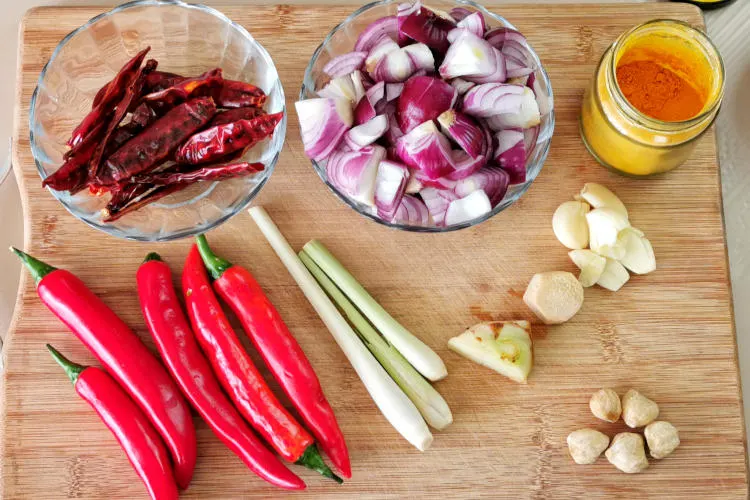
2. Fried the chicken and potatoes (optional)
I use chicken and potatoes as the main ingredients, although pork, sausage, cabbage, and carrot are other common ingredients for Devil’s curry.
The chicken is cut into large chunks with bone-in and skin-on. The bones will impart additional flavor to the gravy during simmering. I got some drumsticks from the market and will solely use them in this recipe, but restaurants are more likely to cut the whole chicken into large chunks.
The potatoes should also be cut into large pieces, about one inch in length.
I deep fried the chicken and potatoes in oil lightly, which is an optional step. You may want to simplify the steps by directly adding the raw chicken and potatoes into the curry gravy. However, deep-fried chicken and potatoes taste better, and therefore I use the same method for other curry chicken dishes.
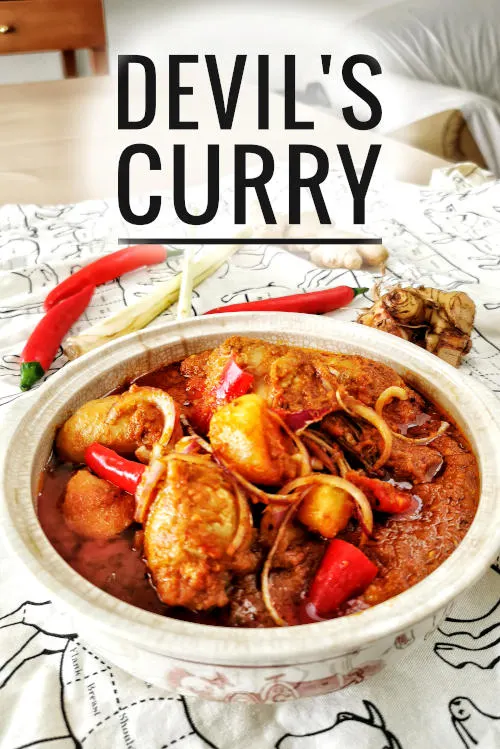
3. Cook the curry
I break down the cooking method into a few sections as below:
a. Deep-fried the ginger, shallot, and chili
- Heat 3/4 cup (or 200ml) of vegetable oil in a large skillet or wok to moderate heat. I suggest using a large vessel as the chili paste will splash when simmering in the later step, making the stovetop quite dirty.
- Add the onion rings to the oil to deep-fry for two minutes, followed by the finely julienned ginger and red chilies. Since the ginger and chilies require a shorter time to deep-fry, You should add them to the oil later than the onion rings.
- When the onion turns to light golden, remove all the items with a wire mesh strainer. Set them aside and leave the clean oil in the wok.
b. Cook the spice paste until the oil is separated
- Place a tablespoon of mustard seeds in a mortar, break up the seeds with the pestle. It does not need to be finely ground and should be Ok when it looks like crushed black peppers.
- Place the crushed mustard seeds into the oil. Let it sizzle for half a minute or until aromatic, then add the spice paste we prepared in the previous step.
- Since I did not include fresh turmeric in the spice paste, I added half a teaspoon of turmeric powder as the substitute.
- Turn down the heat to simmer the spice mixture for about twenty minutes. During this time, the water will start to evaporate from the mixture and gradually become thicker. Give it a few stirs from time to time to prevent the spice from sticking to the pan. Bubbles will usually burst, erupt, and splash vigorously during simmering, so it is best to use low heat to keep your table clean. You can also cover it with a lid to reduce splashes.
- It will take approximately twenty minutes to evaporate all the water added to the spices while blending it. When this happens, the spice mixture will become thick and turn to a paste, and you will notice the oil will start to separate from the paste. When this happens, the spice mixture is done.
c. Add the chicken and potatoes
- Now add the chicken to the wok, and add roughly a cup of water. Mix the spice with the chicken, followed by the potatoes, and then let it simmer.
- The chicken will take about twenty minutes to cook. If you are unsure, use a kitchen thermometer to check the internal temperature of the thickest part of the meat, which should reach 70°C/160°F.
- You may want to add more water if it is too dry or prefers to have more gravy. You can simmer it longer if you prefer the potatoes to become softer. The chicken will remain tender as long as you simmer over low heat.
d. Season the Devil’s curry
While simmering the curry, season it with salt, curry powder, white vinegar, soy sauce, and sugar. You should do a taste test because the amount of salt and other seasonings depends on the amount of water you add, based on your preference for the thickness of the gravy.
- White vinegar is almost universally used in all Devils’ curry recipes. It makes it taste different from other curries that go without it.
- You also need some sugar to balance the acidity.
- I add some Kashmiri curry powder which renders a bright red color to the curry.
- The taste is better if you include some dark soy sauce. It also helps to darken the color of the curry slightly.
4. How to serve and store the Devil’s curry
Before removing the curry from the wok, return the fried onion, ginger, and chilies in step 3 (a) to the curry. Give it a few stirs and dish out.
Devil’s curry is best to serve with steamed rice. It tastes better a few hours after cooking when the flavor has been absorbed into the meat.
The curry is stable for a day or two in the refrigerator and is freezer-friendly if you intend to keep it longer.
The difference between Devil’s curry and Devil’s chicken
Devil’s curry (Debal curry) is not the same as Devil’s chicken (Pollo Diablo), a Spanish chicken dish. However, sometimes we also call the Devil’s curry prepared with chicken as Devil’s chicken in the local context.
Other similar recipes to Devil’s curry (debal curry)
Kapitan chicken is truly a Malaysian curry, amalgamating the diverse array of Malay, Chinese, and Indian eating cultures. This Nyonya chicken dish has many similarities to Devil’s chicken and is added with kaffir lime leaves and local shrimp paste called belacan.
Lamb vindaloo is a classic Indian curry with an intense flavor of spices with a deep earth undertone. It is also cooked with vinegar, dried chilies, and mustard seeds, just like Devils’ chicken, due to the influence of the Portuguese way of cooking.
Devil's curry - how to make authentic curry debal with chicken
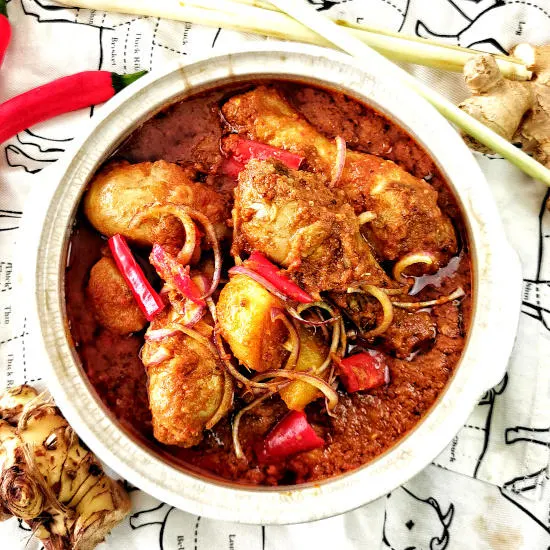
Devil’s curry is the name given to traditional dishes from Malacca’s Portuguese community. It is another name given to the Debal curry, which is usually served during Christmas. The curry is supposed to be very spicy (which I toned down the heat in my recipe), and the color looks fiercely hot and spicy, which is why it is fondly called Devil’s curry.
Ingredients
Ingredients A (to blend)
- 300g onions, cut into large chunks
- 20g dried chilies (dried weight)
- 5 red chilies (or 150g)
- 5 candlenuts**
- 4 cloves garlic
- 3 stalk lemongrass
- 15g galangal, about one inch in length
- 15g ginger, about one inch in length
- 1/2 tsp turmeric powder*
- 1/4 cup water
Ingredients B (to fry)
- 200 ml vegetable oil
- 1 inch ginger, thinly julienned
- 1 onion, cut into rings
- 2 fresh red chilies, cut into short sections
Ingredients C (Others)
- 1 tbsp crushed mustard seeds (coarsely ground with mortar and pestle)
- 1 kg chicken, cut into chunks
- 3 potatoes, medium size, cut into large cubes
- 1 tbsp dark soy sauce
- 1.5 tsp salt
- 2 tbsp white vinegar
- 2 tbsp brown sugar
- 2 tbsp chili powder
Instructions
Prepare the curry paste
- Peel and cut the onions into large chunks.
- Cut the dried chilies into sections and remove the seeds. Soak in hot water for twenty minutes.
- Cut the fresh chilies into sections, remove the seeds.
- Lemongrass. Remove the fibrous outer sheath, cut off the green section, cut into short segments.
- Cut the galangal and ginger into small pieces.
- Blend the ingredients in A finely with some water.
Cook the curry
- Deep-fried the onion rings to the oil to deep-fry for two minutes, followed by the finely julienned ginger and red chilies until lightly golden, remove and drain. (These are the ingredients in B).
- Deep-fried the chicken and potatoes in oil lightly until slightly brown, removed, and drained. (This step is optional)
- Place the crushed mustard seeds into the oil. Let it sizzle for half a minute, then add the spice paste (Ingredients A).
- Add the turmeric powder.
- Simmer the spice mixture for about twenty minutes until the oil separates from the spice paste.
- Add the chicken, potatoes, and water.
- Simmer for 20 minutes or until the chicken is cooked.
- Season with salt, curry powder, white vinegar, dark soy sauce, and sugar.
- Return the fried onion, ginger, and chilies to the curry. Give it a few stirs and dish out.
Notes
*Or use 1/2 inch fresh turmeric
** Alternative: Use macadamia nuts or cashew nuts
Recommended Products
As an Amazon Associate and member of other affiliate programs, I earn from qualifying purchases.
-
 Dried Galangal, Sliced | Greater Galangal - Alpinia Galanga | Perfect for Tom Yum and Tom Kha Soups 3.5 oz.
Dried Galangal, Sliced | Greater Galangal - Alpinia Galanga | Perfect for Tom Yum and Tom Kha Soups 3.5 oz. -
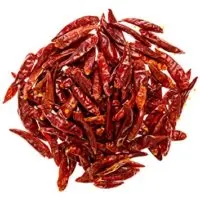 Soeos Szechuan Dried Chili,Dry Szechuan Pepper, Dry Chile Peppers, Sichuan Pepper, Dried Red Chilies, 4oz, (Very Mild Spicy)
Soeos Szechuan Dried Chili,Dry Szechuan Pepper, Dry Chile Peppers, Sichuan Pepper, Dried Red Chilies, 4oz, (Very Mild Spicy) -
 Thai Fresh Lemongrass - 8 stalks
Thai Fresh Lemongrass - 8 stalks -
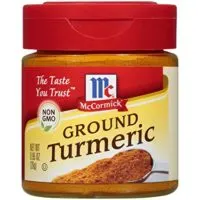 McCormick Ground Turmeric, 0.95 oz
McCormick Ground Turmeric, 0.95 oz
Nutrition Information:
Yield:
10Serving Size:
1Amount Per Serving: Calories: 599Total Fat: 41gSaturated Fat: 7gTrans Fat: 0gUnsaturated Fat: 32gCholesterol: 94mgSodium: 522mgCarbohydrates: 31gFiber: 4gSugar: 8gProtein: 29g
This data was provided and calculated by Nutritionix on 9/16/2021

Narda K Trevino
Monday 18th of October 2021
Thank you this is an authentic, easy to follow and super delicious recipe! Great dinner!
KP Kwan
Friday 17th of September 2021
Hi, this is KP Kwan. I am happy to see you in this comment area, as you have read through my recipe. I am glad to reply to any questions and comments as soon as possible.